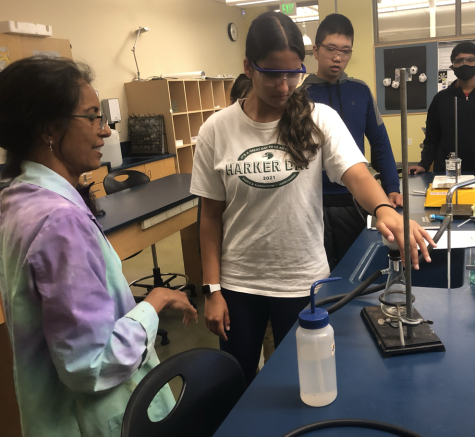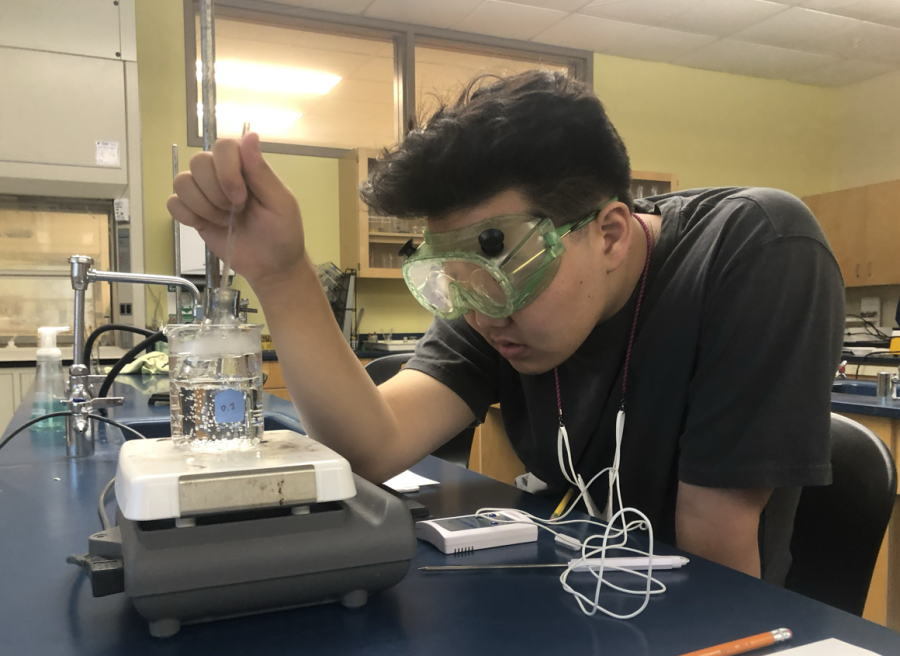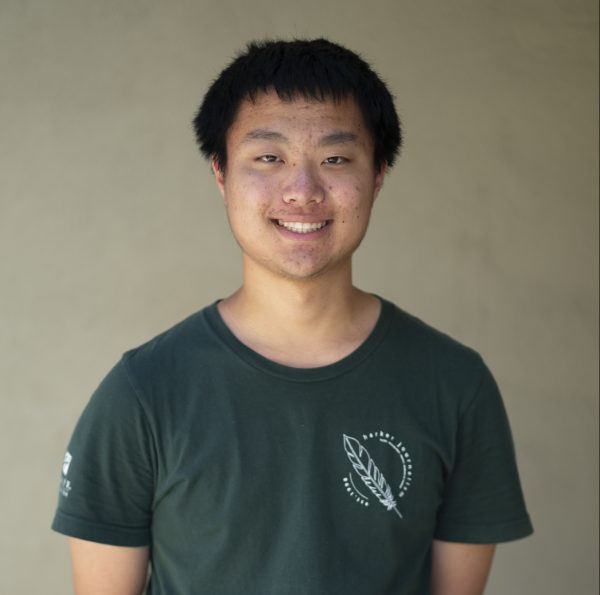Chemistry classes create aspirin for lab
Jason Shim (10) observes a beaker while participating in the AP Chemistry lab. Students in the classes created aspirin during a lab from Oct. 6 to Oct. 10.
October 19, 2022
Students in upper school chemistry teachers Dr. Mala Raghavan and Dr. Casey Brown’s Advanced Placement (AP) chemistry classes created aspirin during a lab from Oct. 6 to Oct. 10.
On the first day of the lab, students mixed salicylic acid and acetic anhydride to create a clear solution called acetylsalicylic acid, also known as aspirin. To crystalize the aspirin compound, lab partners then placed their beakers of solution into an ice bath, and after around 10 minutes, students saw aspirin crystals settling to the bottom of their beakers and collected the crystals after filtration. The students waited until the next class period for the aspirin to dry and evaluate their yield, since massing the wet compound would result in inaccurate results. Some students, including Nelson Gou (10), found this process of creating aspirin from raw materials unexpectedly easy.
“I assumed [the process] would just be super complex and you had to like to mix a ton of stuff,” Nelson said. “But it was easier than I thought it would be.”
In the next class period, lab partners determined the purity of their aspirin through two tests: thin-layer paper chromatography and the iron chloride test. More salicylic acid in a student’s aspirin corresponded with higher impurity. All tests required students to compare the amount of salicylic acid in their own aspirin with the amount in commercial aspirin, which is completely pure.
With thin-layer chromatography, students put the three substances onto a paper coated with silica gel and allowed a fluid to wash away the substances. Depending on how fast different compounds traveled, students could identify how much salicylic acid ended up in their aspirin.
The second test also used the same three samples, but students pipetted a drop of iron chloride into the three compounds. In this case, the darker the solution, the more impure the sample was.
This lab served as hands-on practice by requiring students to use the knowledge learned from class to draw inferences and conclusions.
“This was helpful in applying the [concepts] we learned in class,” Nelson said. “I just didn’t really know you could synthesize a drug. Not every drug is made this way obviously but it [was] cool to see it [happen].”



















![“[Building nerf blasters] became this outlet of creativity for me that hasn't been matched by anything else. The process [of] making a build complete to your desire is such a painstakingly difficult process, but I've had to learn from [the skills needed from] soldering to proper painting. There's so many different options for everything, if you think about it, it exists. The best part is [that] if it doesn't exist, you can build it yourself," Ishaan Parate said.](https://harkeraquila.com/wp-content/uploads/2022/08/DSC_8149-900x604.jpg)




![“When I came into high school, I was ready to be a follower. But DECA was a game changer for me. It helped me overcome my fear of public speaking, and it's played such a major role in who I've become today. To be able to successfully lead a chapter of 150 students, an officer team and be one of the upperclassmen I once really admired is something I'm [really] proud of,” Anvitha Tummala ('21) said.](https://harkeraquila.com/wp-content/uploads/2021/07/Screen-Shot-2021-07-25-at-9.50.05-AM-900x594.png)







![“I think getting up in the morning and having a sense of purpose [is exciting]. I think without a certain amount of drive, life is kind of obsolete and mundane, and I think having that every single day is what makes each day unique and kind of makes life exciting,” Neymika Jain (12) said.](https://harkeraquila.com/wp-content/uploads/2017/06/Screen-Shot-2017-06-03-at-4.54.16-PM.png)








![“My slogan is ‘slow feet, don’t eat, and I’m hungry.’ You need to run fast to get where you are–you aren't going to get those championships if you aren't fast,” Angel Cervantes (12) said. “I want to do well in school on my tests and in track and win championships for my team. I live by that, [and] I can do that anywhere: in the classroom or on the field.”](https://harkeraquila.com/wp-content/uploads/2018/06/DSC5146-900x601.jpg)
![“[Volleyball has] taught me how to fall correctly, and another thing it taught is that you don’t have to be the best at something to be good at it. If you just hit the ball in a smart way, then it still scores points and you’re good at it. You could be a background player and still make a much bigger impact on the team than you would think,” Anya Gert (’20) said.](https://harkeraquila.com/wp-content/uploads/2020/06/AnnaGert_JinTuan_HoHPhotoEdited-600x900.jpeg)

![“I'm not nearly there yet, but [my confidence has] definitely been getting better since I was pretty shy and timid coming into Harker my freshman year. I know that there's a lot of people that are really confident in what they do, and I really admire them. Everyone's so driven and that has really pushed me to kind of try to find my own place in high school and be more confident,” Alyssa Huang (’20) said.](https://harkeraquila.com/wp-content/uploads/2020/06/AlyssaHuang_EmilyChen_HoHPhoto-900x749.jpeg)








